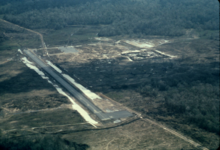
Operation Starlite was the first major offensive action conducted by a purely U.S. military unit during the Vietnam War from 18 to 24 August 1965. The operation was launched based on intelligence provided by Major general Nguyen Chanh Thi, the Army of the Republic of Vietnam (ARVN) I Corps commander. III Marine Amphibious Force commander Lieutenant General Lewis W. Walt devised a plan to launch a pre-emptive strike against the Viet Cong (VC) 1st Regiment to nullify their threat to the vital Chu Lai Air Base and Base Area and ensure that its powerful communication tower remained intact.
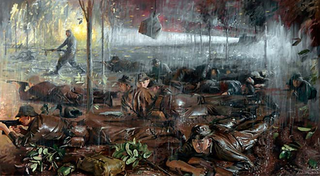
The Battle of Long Tan took place in a rubber plantation near Long Tân, in Phước Tuy Province, South Vietnam, during the Vietnam War. The action was fought between Viet Cong (VC) and People's Army of Vietnam (PAVN) units and elements of the 1st Australian Task Force.

The Battle of Coral–Balmoral was a series of actions fought during the Vietnam War between the 1st Australian Task Force and the North Vietnamese People's Army of Vietnam (PAVN) 7th Division and Viet Cong (VC) Main Force units, 40 kilometres (25 mi) north-east of Saigon. Following the defeat of the PAVN/VC Tet offensive in January and February, in late April two Australian infantry battalions—the 1st and 3rd Battalions of the Royal Australian Regiment (RAR)—with supporting arms, were again deployed from their base at Nui Dat in Phước Tuy Province to positions astride infiltration routes leading to Saigon to interdict renewed movement against the capital. Part of the wider allied Operation Toan Thang I, it was launched in response to intelligence reports of another impending PAVN/VC offensive, yet the Australians experienced little fighting during this period. Meanwhile, the PAVN/VC successfully penetrated the capital on 5 May, plunging Saigon into chaos during the May Offensive in an attempt to influence the upcoming Paris peace talks scheduled to begin on the 13th. During three days of intense fighting the attacks were repelled by US and South Vietnamese forces, and although another attack was launched by the PAVN/VC several days later, the offensive was again defeated with significant losses on both sides, causing extensive damage to Saigon and many civilian casualties. By 12 May the fighting was over, and the PAVN/VC were forced to withdraw having suffered heavy casualties. US casualties were also heavy and it proved to be their most costly week of the war.
The Battle of FSB Mary Ann occurred when Viet Cong (VC) sappers attacked a U.S. firebase located in Quảng Tín Province, South Vietnam early on the morning of 28 March 1971.

The First Battle of Loc Ninh took place during the Vietnam War that occurred between 29 October and 7 November 1967, fought by the Viet Cong, Army of the Republic of Vietnam (ARVN), Civilian Irregular Defense Group and the United States Army.

The Battle of Hat Dich was a series of military actions fought between an allied contingent, including the 1st Australian Task Force and the People's Army of Vietnam (PAVN) and Viet Cong (VC) during the Vietnam War. Under the code name Operation Goodwood, two battalions from 1 ATF deployed away from their base in Phước Tuy Province, operating against suspected PAVN/VC bases in the Hat Dich area, in western Phước Tuy, south-eastern Biên Hòa and south-western Long Khánh provinces as part of a large allied sweep known as Operation Toan Thang II. The Australians and New Zealanders conducted sustained patrolling throughout the Hat Dich and extensively ambushed tracks and river systems in the Rung Sat Special Zone, occupying a series of fire support bases as operations expanded. Meanwhile, American, South Vietnamese and Thai forces also operated in direct support of the Australians as part of the division-sized action.
Operation Prairie IV was an operation conducted by the United States Marine Corps in the area around Con Thien, South Vietnam known as Leatherneck Square from 20 April until 17 May 1967. During the course of the fighting Marine casualties were 164 killed 1,240 wounded while claiming 505 People's Army of Vietnam (PAVN) killed and 9 captured.
The Battle of Prek Klok I occurred on February 28, 1967 during Operation Junction City, a search and destroy mission by American military forces in Tay Ninh Province of South Vietnam, to the west of the capital Saigon. A few days before the battle, the 1st Battalion, 16th Infantry Regiment was brought into the area near Suối Đá and Prek Klok to defend a highway, airfield, and artillery base in the area, and to carry out search and destroy operations around it. On the morning of 28 February, elements of the battalion headed east, and were attacked from the front by Viet Cong (VC) infantry with gunfire, rockets and mortars. Soon after, they were attacked from all fronts as the VC tried to surround them with a battalion-sized force. However, with superior firepower available, the Americans called in air strikes and artillery, and by mid afternoon, had repelled the VC attacks. The Americans lost 25 killed while the VC lost 167.
The second battle of Bàu Bàng occurred during the night of 19–20 March 1967 during Operation Junction City, a search and destroy mission by American military forces in Tay Ninh Province of South Vietnam, to the west of the capital Saigon.
The Battle of Ap Gu occurred during 31 March and 1 April 1967 during Operation Junction City, a search and destroy mission by American military forces in Tay Ninh Province of South Vietnam, to the west of the capital Saigon. The battle near the border with Cambodia left 609 Viet Cong (VC) killed according to US sources, with 5 captured, and over 50 weapons of all types recovered, while the Americans lost 17 killed and 102 wounded.
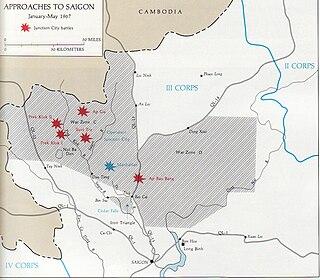
The Battle of Suoi Tre occurred during the early morning of 21 March 1967 during Operation Junction City, a search and destroy mission by American military forces in Tay Ninh Province, South Vietnam. After being challenged heavily to begin with, the Americans gained the upper hand and completed a convincing victory over the Viet Cong (VC). They claimed to have found 647 bodies and captured seven prisoners, while recovering 65 crew-served and 94 individual weapons. The Americans losses were 36 dead and 190 wounded, a fatality ratio of more than twenty to one in their favour.
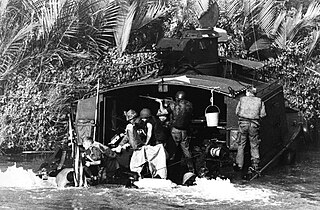
Operation Coronado XI was the eleventh of the Operation Coronado series of riverine military operations conducted by the U.S. Mobile Riverine Force (MRF) and units of the Army of the Republic of Vietnam (ARVN), designed to secure Cần Thơ in the aftermath of the Tet Offensive. It ran from 12 February to 3 March 1968.

The Battle of An Ninh took place from 18–19 September 1965 between elements of the Vietcong (VC) 94th and 95th Battalions, 2nd Regiment, 3rd Division and the U.S. 2nd Battalion, 502nd Infantry Regiment and Army of the Republic of Vietnam (ARVN) Rangers. It occurred during an operation codenamed Operation Gibraltar, developed by MACV to clear the area around the 1st Cavalry Division's base at An Khê, South Vietnam.
Operation Shenandoah II was a security operation conducted during the Vietnam War by the U.S. 1st Infantry Division to secure and repair Highway 13, South Vietnam from 29 September to 19 November 1967.
Phase III of the Tet offensive of 1968 was launched by the People's Army of Vietnam (PAVN) and Viet Cong (VC) from 17 August to 27 September 1968. The offensive was divided into two waves of attacks from 17 to 31 August 1968 and from 11 to 27 September of that same year.

The attack on Tan Son Nhut Air Base, headquarters of the Republic of Vietnam Air Force (RVNAF) and the United States Air Force (USAF) 7th Air Force, occurred during the early hours of 31 January 1968. Tan Son Nhut Air Base was one of the major air bases used for offensive air operations within South Vietnam and for the support of United States Army and Army of the Republic of Vietnam (ARVN) ground operations. The attack by Vietcong (VC) and People's Army of Vietnam (PAVN) forces was one of several major attacks on Saigon in the first days of the Tet offensive. The attack was repulsed with the VC/PAVN suffering heavy losses; only superficial damage was done to the base.

The attacks on Biên Hòa, Bien Hoa Air Base and Long Binh Post, occurred during the early hours of 31 January 1968 and continued until 2 February 1968. The attacks by Vietcong (VC) and People's Army of Vietnam (PAVN) forces were one of several major attacks around Saigon in the first days of the Tet offensive. The attacks were repulsed with the PAVN/VC suffering heavy losses, having inflicted minimal damage on the bases.
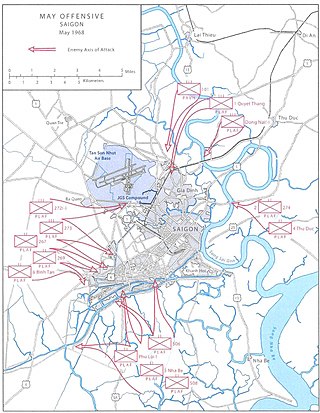
The Battle of South Saigon took place from 7–12 May 1968 during the Vietcong (VC) May Offensive of the Vietnam War. Four VC battalions attempted to advance over a series of bridges into south Saigon, but were blocked by US Army units and eventually forced to retreat with heavy losses.
Firebase O'Reilly is a former Army of the Republic of Vietnam (ARVN) firebase located south of Quảng Trị in Quảng Trị Province, Vietnam.
Operation MacArthur was a United States Army military operation in the Central Highlands of South Vietnam from 12 October 1967 to 31 January 1969. The early phases of the operation encompassed the Battle of Dak To from 3 to 23 November 1967.
